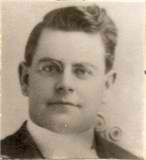Erastus Kruse Fillerup
(1875 – 1910)
My father, Erastus Kruse Fillerup, son of Anders Peter and Caroline Rasmine (Rasmussen) Fillerup, was born in Lake View, Utah on February 16, 1875.
He was the fifth of nine children, six boys and three girls. His parents were immigrants from Denmark. He attended the Lake View Elementary School, then entered the Brigham Young Academy, graduating from that institution in 1895.
On May 31, he was set apart by Heber J. Grant and June 1 of that year he left for a mission to the southern states, where he served 2 and a half years, chiefly in Tennessee. He reported his mission at the church offices December 26, 1897, and was called by President Wilford Woodruff of the Church of Jesus Christ of Latter-day Saints to teach in the elementary school of Colonia Diaz, Mexico, which was a church school. He was also instructed to remain in Mexico until he was called elsewhere.
Here he met Lucy Ann Johnson and on May 18, 1899, he married her in the Salt Lake Temple. Lacking the proper chaperone they were not allowed to travel the long distance from Diaz, Mexico to Salt Lake City together. Lucy was sent ahead with a Mrs. Galbraith to stay with his parents until he arrived for the wedding. They were the parents of six children, the youngest of whom, Drexel, was born five days after his father’s death.
Erastus Kruse took a very active part in all church organizations in the Ward and was a Counselor in the Bishopric for a time. He loved to take part in dramatics, and let the Ward choir.
In 1905 he was called to teach horticulture in the Juarez Stake Academy at Colonia Juarez, Mexico. There again, after but a short time he was called to the Bishopric, and work in the MIA Stake Board. As band and choir later, along with his other activities, he had meetings every night of the month but one.
Erastus was a friend to everybody and tried to influence those in his classes with the desire to get an education. To his students he used to say, “Set your aims high and work to reach them. There is no honor in reaching goals that require little or no effort.” He had a way of holding his students up to their best without preaching urging. It is said that none slept in his classes.
Death came to Erastus Kruse Fillerup on July 2, 1910, in the little town of Pearson, Mexico. He was doing construction work on a bridge and fell, being killed instantly. He was buried in Colonia Juarez. The Bishop, Joseph C. Bentley, made the remark that it would take ten men to replace them.
In 1912 in the Mormon colonists were forced to abandon their homes and possessions because of the Revolution, Lulu, with her six children, went to Tucson, Arizona where she stayed about a year. The next year she stayed about a year. The next two years she lived on the Provo bench, now Orem. Her children attended the Lake View Elementary school and BYU Training School. During this time her helpless poor and it was a struggle for providing care for a family. She moved to Ammon, Idaho to be near her parents and sisters, who homesteaded farms there. We went out on maternity cases into general nursing care for invalids and other work, getting fine service to her fellow sisters.
After six years she moved to Logan, Utah, where her children could have the opportunity for better schooling, and she secured steady work cooking for the fraternity houses. During the summer months she was employed by Deseret Livestock Company on their ranch in Evanston, Wyoming.
Later, on a trip to Cedar city to visit her daughter, Thelda, she met a man who was energetic and ambitious in his work. By trade he was a carpenter and built homes to rent and sell. He also did bricklaying and other work in the construction of houses. He was a widower and alone as she was. On April 19, 1931, Lulu married Martin Ray Tanner in Salt Lake City, Utah. For a time they lived in Cedar City; then they moved to Salt Lake City in 1946, where he managed apartment houses. Lulu, ever ambitious to be doing work, continued to work. For a while she sewed for the Deseret industries. She also worked as a pastry cook for the ZCMI cafeteria.
With Martin’s failing health, they moved to Mesa, Arizona, where they lived quietly and happily doing temple work and other activities in their church. Lulu passed away in 1969.
Irva Fillerup Huber, daughter
Stalwarts South of the Border, Nelle Spilsbury Hatch page 197
Thanks for Phil Stover for sharing this power point.
Erastus Fillerup powerpoint by Phil Stover (file will download when link is clicked).

